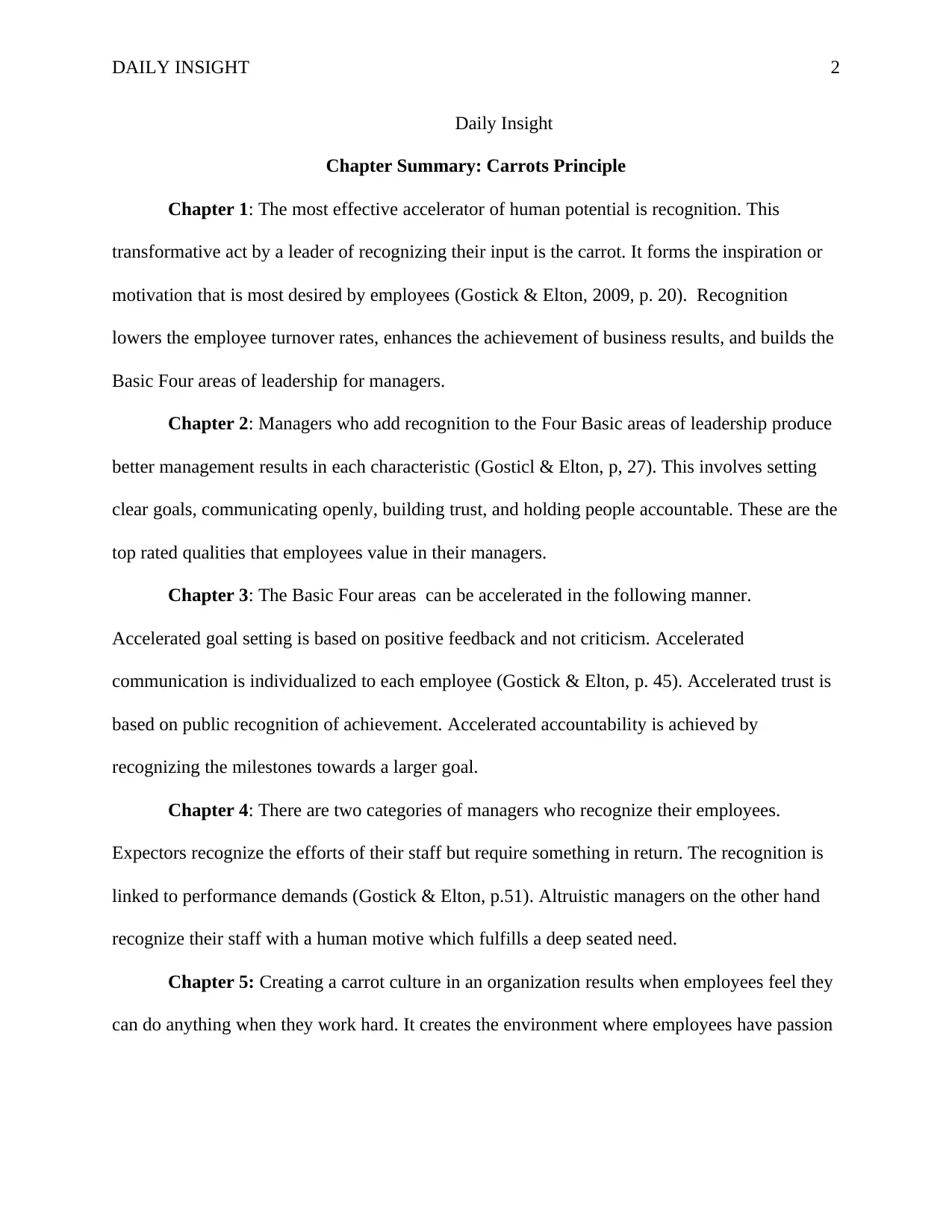Daily Insight: The Carrot Principle - Summary and Application
VerifiedAdded on 2023/06/13
|5
|1065
|251
Essay
AI Summary
This essay presents a daily insight into Adrian Gostick and Chester Elton's "The Carrot Principle," summarizing key chapters and reflecting on personal experiences with different management styles. The summary covers the core concepts of the book, including the importance of employee recognition, the acceleration of basic leadership principles, and the creation of a Carrot Culture within organizations. The author reflects on experiences with both an "expector" manager, who provided recognition with expectations of reciprocation, and an "altruist" manager, whose genuine recognition motivated exceptional performance. The essay concludes by emphasizing the power of recognition in driving employee engagement and organizational success. Desklib offers similar solved assignments and study resources for students.

Running head: DAILY INSIGHT 1
Daily Insight
Name
Academic Institution
Author Note
Class
Professor
August 29, 2024
Daily Insight
Name
Academic Institution
Author Note
Class
Professor
August 29, 2024
Paraphrase This Document
Need a fresh take? Get an instant paraphrase of this document with our AI Paraphraser

DAILY INSIGHT 2
Daily Insight
Chapter Summary: Carrots Principle
Chapter 1: The most effective accelerator of human potential is recognition. This
transformative act by a leader of recognizing their input is the carrot. It forms the inspiration or
motivation that is most desired by employees (Gostick & Elton, 2009, p. 20). Recognition
lowers the employee turnover rates, enhances the achievement of business results, and builds the
Basic Four areas of leadership for managers.
Chapter 2: Managers who add recognition to the Four Basic areas of leadership produce
better management results in each characteristic (Gosticl & Elton, p, 27). This involves setting
clear goals, communicating openly, building trust, and holding people accountable. These are the
top rated qualities that employees value in their managers.
Chapter 3: The Basic Four areas can be accelerated in the following manner.
Accelerated goal setting is based on positive feedback and not criticism. Accelerated
communication is individualized to each employee (Gostick & Elton, p. 45). Accelerated trust is
based on public recognition of achievement. Accelerated accountability is achieved by
recognizing the milestones towards a larger goal.
Chapter 4: There are two categories of managers who recognize their employees.
Expectors recognize the efforts of their staff but require something in return. The recognition is
linked to performance demands (Gostick & Elton, p.51). Altruistic managers on the other hand
recognize their staff with a human motive which fulfills a deep seated need.
Chapter 5: Creating a carrot culture in an organization results when employees feel they
can do anything when they work hard. It creates the environment where employees have passion
Daily Insight
Chapter Summary: Carrots Principle
Chapter 1: The most effective accelerator of human potential is recognition. This
transformative act by a leader of recognizing their input is the carrot. It forms the inspiration or
motivation that is most desired by employees (Gostick & Elton, 2009, p. 20). Recognition
lowers the employee turnover rates, enhances the achievement of business results, and builds the
Basic Four areas of leadership for managers.
Chapter 2: Managers who add recognition to the Four Basic areas of leadership produce
better management results in each characteristic (Gosticl & Elton, p, 27). This involves setting
clear goals, communicating openly, building trust, and holding people accountable. These are the
top rated qualities that employees value in their managers.
Chapter 3: The Basic Four areas can be accelerated in the following manner.
Accelerated goal setting is based on positive feedback and not criticism. Accelerated
communication is individualized to each employee (Gostick & Elton, p. 45). Accelerated trust is
based on public recognition of achievement. Accelerated accountability is achieved by
recognizing the milestones towards a larger goal.
Chapter 4: There are two categories of managers who recognize their employees.
Expectors recognize the efforts of their staff but require something in return. The recognition is
linked to performance demands (Gostick & Elton, p.51). Altruistic managers on the other hand
recognize their staff with a human motive which fulfills a deep seated need.
Chapter 5: Creating a carrot culture in an organization results when employees feel they
can do anything when they work hard. It creates the environment where employees have passion

DAILY INSIGHT 3
for their work which is translated into performance (Gostick & Elton, p. 64). The recognition in
this instance is seen through the eyes of the employees toward their manager.
Chapter 6: Before embarking on creating a Carrot Culture, managers should measure the
satisfaction and engagement of their employees. Workplace attitude surveys measure the staff
engagement and satisfaction. Managers build satisfaction and engagement by asking, “what’s
important here, how can I make a difference, and what’s in it for me when I make a difference”
(Gostick & Elton, p. 78).
Chapter 7: The building blocks of a Carrot Culture include the culture of celebration
founded on employee recognition. Managers create this culture one person at a time on daily
recognition (Gostick & Elton, p. 83). Above-and beyond recognition, career recognition, and
celebration events all contribute to building a Carrot culture in an organization. These blocks
should be specific, timely, and frequent.
Chapter 8: Managers give different reasons for the fear of recognizing their employees.
Instead of complex recognition programs, organizations should adopt programs which are
strategic (aligned with core values and goals), simple, measured (provide a return on
investment), and owned by senior leaders and managers (Gostick & Elton, p. 106). These steps
will help overcome the phobia of recognition.
Chapter 9: The Carrot Culture is a global acceleration based on recognition. Employees
are consistent globally on their engagement based on three predictors. These are trust,
opportunity and well-being, and pride in the organizational symbol (Gostick & Elton, p. 113).
Such employees are motivated to contribute to the success of their organization.
Chapter 10: The manager is the Carrot calculator and is tasked with providing motivating
rewards to those who deserve (Gostick & Elton, p. 128). Managers determine the level of award,
for their work which is translated into performance (Gostick & Elton, p. 64). The recognition in
this instance is seen through the eyes of the employees toward their manager.
Chapter 6: Before embarking on creating a Carrot Culture, managers should measure the
satisfaction and engagement of their employees. Workplace attitude surveys measure the staff
engagement and satisfaction. Managers build satisfaction and engagement by asking, “what’s
important here, how can I make a difference, and what’s in it for me when I make a difference”
(Gostick & Elton, p. 78).
Chapter 7: The building blocks of a Carrot Culture include the culture of celebration
founded on employee recognition. Managers create this culture one person at a time on daily
recognition (Gostick & Elton, p. 83). Above-and beyond recognition, career recognition, and
celebration events all contribute to building a Carrot culture in an organization. These blocks
should be specific, timely, and frequent.
Chapter 8: Managers give different reasons for the fear of recognizing their employees.
Instead of complex recognition programs, organizations should adopt programs which are
strategic (aligned with core values and goals), simple, measured (provide a return on
investment), and owned by senior leaders and managers (Gostick & Elton, p. 106). These steps
will help overcome the phobia of recognition.
Chapter 9: The Carrot Culture is a global acceleration based on recognition. Employees
are consistent globally on their engagement based on three predictors. These are trust,
opportunity and well-being, and pride in the organizational symbol (Gostick & Elton, p. 113).
Such employees are motivated to contribute to the success of their organization.
Chapter 10: The manager is the Carrot calculator and is tasked with providing motivating
rewards to those who deserve (Gostick & Elton, p. 128). Managers determine the level of award,
⊘ This is a preview!⊘
Do you want full access?
Subscribe today to unlock all pages.

Trusted by 1+ million students worldwide

DAILY INSIGHT 4
how much to spend and which creative awards to offer to their employees. These tools help staff
to achieve their full potential.
Chapter 11: There are over 125 recognition ideas which managers can use in their
organizations. They are grouped into the five areas of the Carrot Principle: accountability, goal
setting, trust, communication, and recognition (Gostick & Elton, p. 133). These are tested ideas
that are used by managers from around the world.
Personal Experience
My personal experience is with regard to two managers at different organizations where I
worked. My first employment was in a restaurant where the “expector” manager used
recognition while expecting something in return. At the end of the week, deserving employees
who had given exemplary customer services would be given financial rewards as weekend tips.
In return, the manager expected such employees to report in during their off-days. I would
appreciate the manager’s sentiments but was wary of his motives. However, his one-size-fits-all
approach did not take cognizance of what drives me to perform well and lacked the power of
motivation.
My second experience was with an altruist manager while working at a gas station. My
job involved filling customer’s vehicle with gas. I would of my own volition also swipe the
windscreens with soap and water as an extra service. This extra customer care was not demanded
of me but was popular with the customers and drew in plenty of customers. The manager would
give me a cash reward equal to half of my pay at the end of the week. In addition, he would take
the time to sit and question me as to why I provided the extra service. My answer was that my
mentality was I could do anything and with hard work the station would have more business. I
was committed to the success of the gas station based on his recognition of my effort.
how much to spend and which creative awards to offer to their employees. These tools help staff
to achieve their full potential.
Chapter 11: There are over 125 recognition ideas which managers can use in their
organizations. They are grouped into the five areas of the Carrot Principle: accountability, goal
setting, trust, communication, and recognition (Gostick & Elton, p. 133). These are tested ideas
that are used by managers from around the world.
Personal Experience
My personal experience is with regard to two managers at different organizations where I
worked. My first employment was in a restaurant where the “expector” manager used
recognition while expecting something in return. At the end of the week, deserving employees
who had given exemplary customer services would be given financial rewards as weekend tips.
In return, the manager expected such employees to report in during their off-days. I would
appreciate the manager’s sentiments but was wary of his motives. However, his one-size-fits-all
approach did not take cognizance of what drives me to perform well and lacked the power of
motivation.
My second experience was with an altruist manager while working at a gas station. My
job involved filling customer’s vehicle with gas. I would of my own volition also swipe the
windscreens with soap and water as an extra service. This extra customer care was not demanded
of me but was popular with the customers and drew in plenty of customers. The manager would
give me a cash reward equal to half of my pay at the end of the week. In addition, he would take
the time to sit and question me as to why I provided the extra service. My answer was that my
mentality was I could do anything and with hard work the station would have more business. I
was committed to the success of the gas station based on his recognition of my effort.
Paraphrase This Document
Need a fresh take? Get an instant paraphrase of this document with our AI Paraphraser

DAILY INSIGHT 5
References
Gostick, A., & Elton, C. (2009). The Carrot Principle. New York: Free Press.
References
Gostick, A., & Elton, C. (2009). The Carrot Principle. New York: Free Press.
1 out of 5
Related Documents
Your All-in-One AI-Powered Toolkit for Academic Success.
+13062052269
info@desklib.com
Available 24*7 on WhatsApp / Email
![[object Object]](/_next/static/media/star-bottom.7253800d.svg)
Unlock your academic potential
Copyright © 2020–2025 A2Z Services. All Rights Reserved. Developed and managed by ZUCOL.





